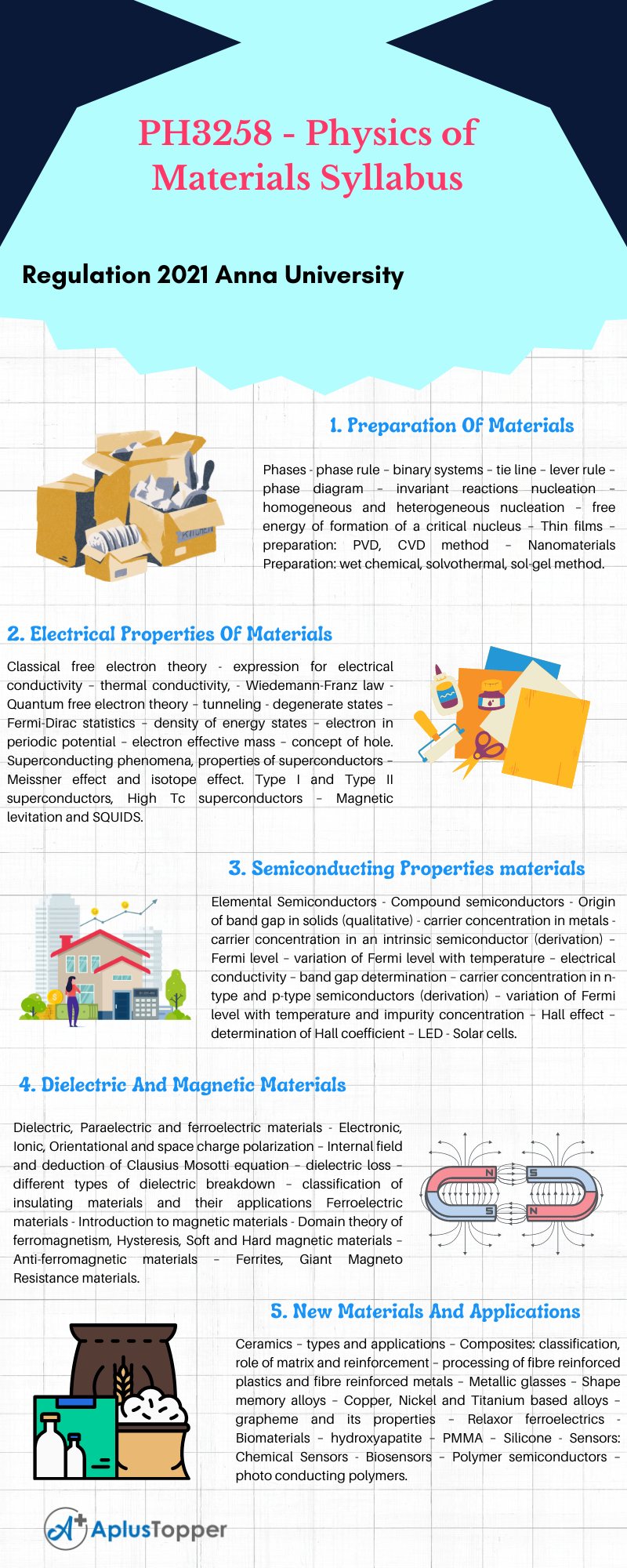Regulation 2021 Anna University Code – PH3258 deals with the semester – II Physics of Materials Syllabus of B.Tech Chemical Engineering. Most of the semester syllabus tries to give both practical and theoretical knowledge to the students. To acquire the proper knowledge regarding the studies to prepare for the examination, need a detailed syllabus right?
This article will assist you in gaining most of the syllabus details. We tried our best to provide the required syllabus info. Chapter-wise syllabus along with reference books written by experts and textbooks added. Hence in this article PH3258 – Physics of Materials syllabus, we include all the details regarding the examination. Students can easily get all the data regarding the syllabus on one page. Hope you will understand the syllabus. And All the best for your exams. Don’t forget to share it with your friends.
If you want to know more about the syllabus of B.Tech Chemical Engineering connected to an affiliated institution’s four-year undergraduate degree program. We provide you with a detailed Year-wise, semester-wise, and Subject-wise syllabus in the following link B.Tech Chemical Engineering Syllabus Anna University Regulation 2021.
Aim Of Objectives:
- To make the students to understand the basics of phase diagrams and various materials preparation techniques
- To equip the students to have a knowledge on different types of electron theory, basics of quantum mechanics and superconductors.
- To introduce the physics of semiconducting materials and applications of semiconductors in device fabrication
- To familiarize the students with the theory and applications of magnetic and dielectric materials
- To provide the students a sound platform towards learning about advanced materials and their applications.
PH3258 – Physics of Materials Syllabus
Unit I: Preparation Of Materials
Phases – phase rule – binary systems – tie line – lever rule – phase diagram – invariant reactions nucleation – homogeneous and heterogeneous nucleation – free energy of formation of a critical nucleus – Thin films – preparation: PVD, CVD method – Nanomaterials Preparation: wet chemical, solvothermal, sol-gel method.
Unit II: Electrical Properties Of Materials
Classical free electron theory – expression for electrical conductivity – thermal conductivity, – Wiedemann-Franz law – Quantum free electron theory – tunneling – degenerate states – Fermi-Dirac statistics – density of energy states – electron in periodic potential – electron effective mass – concept of hole. Superconducting phenomena, properties of superconductors – Meissner effect and isotope effect. Type I and Type II superconductors, High Tc superconductors – Magnetic levitation and SQUIDS.

Unit III: Semiconducting Properties materials
Elemental Semiconductors – Compound semiconductors – Origin of band gap in solids (qualitative) – carrier concentration in metals – carrier concentration in an intrinsic semiconductor (derivation) – Fermi level – variation of Fermi level with temperature – electrical conductivity – band gap determination – carrier concentration in n-type and p-type semiconductors (derivation) – variation of Fermi level with temperature and impurity concentration – Hall effect – determination of Hall coefficient – LED – Solar cells.
Unit IV: Dielectric And Magnetic Materials
Dielectric, Paraelectric and ferroelectric materials – Electronic, Ionic, Orientational and space charge polarization – Internal field and deduction of Clausius Mosotti equation – dielectric loss – different types of dielectric breakdown – classification of insulating materials and their applications Ferroelectric materials – Introduction to magnetic materials – Domain theory of ferromagnetism, Hysteresis, Soft and Hard magnetic materials – Anti-ferromagnetic materials – Ferrites, Giant Magneto Resistance materials.
Unit V: New Materials And Applications
Ceramics – types and applications – Composites: classification, role of matrix and reinforcement – processing of fibre reinforced plastics and fibre reinforced metals – Metallic glasses – Shape memory alloys – Copper, Nickel and Titanium based alloys – grapheme and its properties – Relaxor ferroelectrics – Biomaterials – hydroxyapatite – PMMA – Silicone – Sensors: Chemical Sensors – Biosensors – Polymer semiconductors – photo conducting polymers.
Text Books:
- W.D.Callister and D.G.Rethwish. Materials Science and Engineering. John Wiley & Sons, 2014.
- V.Raghavan. Materials Science and Engineering: A First Course. PHI Learning, 201 5.
- M.F.Ashby, P.J.Ferreira and D.L.Schodek. Nanomaterials, Nanotechnologies and Design: An Introduction for Engineers, 2011.
References:
- J.F.Shackelford. Introduction to Materials Science for Engineers. Pearson, 2015.
- D.R. Askeland and W.J. Wright. Essentials of Materials Science and Engineering, Cengage Learning, 2013.
- Charles Kittel, Introduction to Solid State Physics, Wiley India Edition, 2019.
- Jean P.Mercier, G.Zambelli and W.Kurz, Introduction to Materials Science, Elsevier, 2002.
- Yaser Dahman, Nanotechnology and Functional Materials for Engineers, Elsevier, 2017.
Related Posts On Semester – II:
- HS3252 – Professional English – II
- MA3251 – Statistics and Numerical
- BE3252 – Basic Electrical, Electronics and Instrumentation Engineering
- GE3251 – Engineering Graphics
- CH3251 – Introduction to Chemical Engineering
